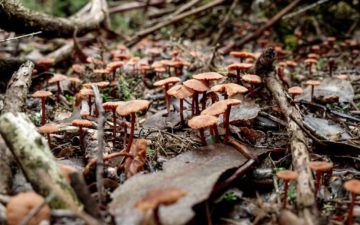Gabriel Pokin in Science:
 CHILE’S VILLARRICA NATIONAL PARK—As a motley medley of mycologists climbed the basalt slopes of the Lanín volcano earlier this year, the green foliage at lower elevations gave way to autumnal golds and reds. Chile’s famed Araucaria—commonly called monkey puzzle trees—soon appeared, their spiny branches curving jauntily upward like so many cats’ tails. Beneath the majestic trees, the scientists were focused on something far less glamorous—indeed, mostly invisible: mycorrhizal fungi, tiny organisms that intertwine with roots of the Araucaria and nearly all the other plants in this forest. The multinational research team had come to collect soil samples they hoped would, with help from DNA testing, reveal exactly which fungi live here, and how they support this complex assemblage of flora. By the end of an exhausting day that included bushwhacking through heavy brush, the fungi hunters had filled seven small plastic sacks with dirt from different locations. “I wouldn’t be surprised if there are 100 undescribed species” of fungi in each bag, said mycologist Giuliana Furci, founder of the Chilean nonprofit Fungi Foundation and one of the expedition leaders.
CHILE’S VILLARRICA NATIONAL PARK—As a motley medley of mycologists climbed the basalt slopes of the Lanín volcano earlier this year, the green foliage at lower elevations gave way to autumnal golds and reds. Chile’s famed Araucaria—commonly called monkey puzzle trees—soon appeared, their spiny branches curving jauntily upward like so many cats’ tails. Beneath the majestic trees, the scientists were focused on something far less glamorous—indeed, mostly invisible: mycorrhizal fungi, tiny organisms that intertwine with roots of the Araucaria and nearly all the other plants in this forest. The multinational research team had come to collect soil samples they hoped would, with help from DNA testing, reveal exactly which fungi live here, and how they support this complex assemblage of flora. By the end of an exhausting day that included bushwhacking through heavy brush, the fungi hunters had filled seven small plastic sacks with dirt from different locations. “I wouldn’t be surprised if there are 100 undescribed species” of fungi in each bag, said mycologist Giuliana Furci, founder of the Chilean nonprofit Fungi Foundation and one of the expedition leaders.
The April ascent was also a road test of sorts: the first of many surveys that the Society for the Protection of Underground Networks (SPUN), a new fungus-focused nonprofit, hopes to conduct. It has raised some $3.5 million for an ambitious effort to map the global distribution of mycorrhizal fungi, which can create subterranean networks that are thought to play a key, but often overlooked, role in shaping ecosystems. “Up to 50% of the living biomass of soils are these networks,” says ecologist Toby Kiers of VU Amsterdam, a co-founder of SPUN and one of the leaders of the Chile expedition. “We have to figure out where they are and what they’re doing.”
More here.
